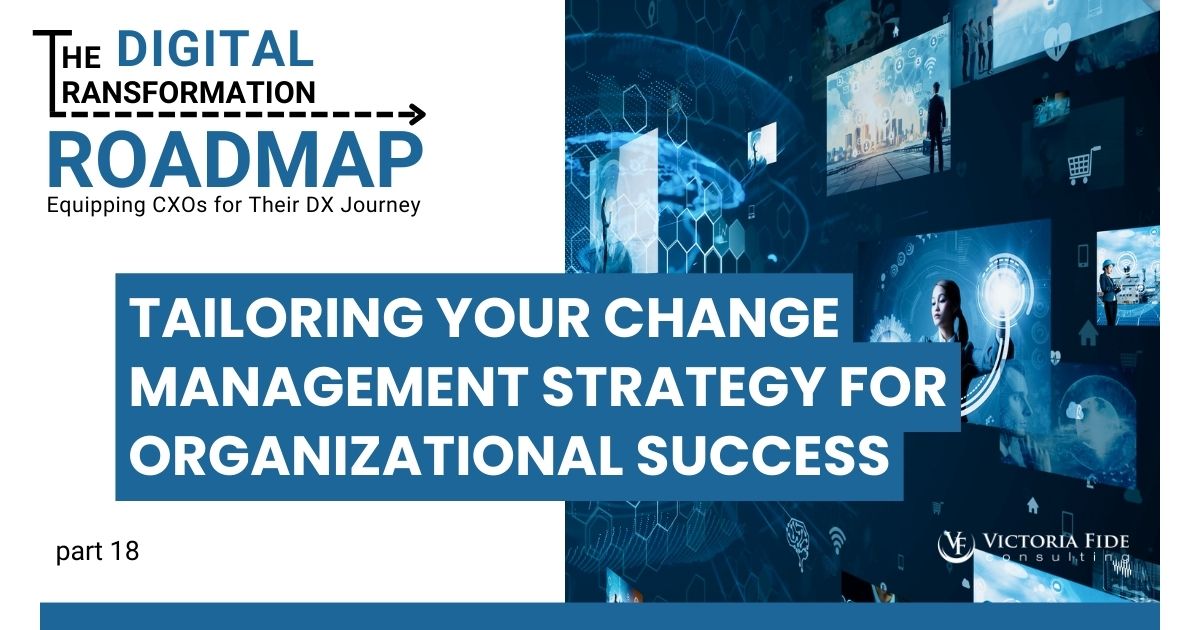
Tailoring Your Change Management Strategy for Organizational Success
The DX Roadmap series is produced by Victoria Fide Marketing with input and oversight from our leadership team and industry SMEs.
It may sound counterintuitive, but studies consistently show it’s the people – not the technology – that form the backbone of digital transformation (DX) projects. Building a strategic change management plan is crucial to ensure seamless collaboration, widespread adoption, and overall success for digital transformation initiatives.
Just as a ship’s captain must maintain crew morale and ensure each member fulfills their roles, a Project Manager of a DX initiative must develop a comprehensive Change Management Strategy to assist in guiding their team through the transformation. This strategy will factor in leadership alignment, stakeholder involvement, level of training necessary, and more, using data from assessments and interviews to inform a more detailed Change Management Plan.
This guide will provide insights on creating a comprehensive Change Management Strategy that will equip your organization and project teams to navigate change with success. With an effective Change Management Strategy, you will ultimately increase your project’s chances of success in achieving the desired objectives and sustaining the benefits long after the project’s completion.
Table of Contents
The Importance of Change Management in DX Projects
Change management is a systematic approach aimed at guiding organizations through change. It involves structured methodologies and practices designed to transition individuals, teams, and organizations from a current state to a desired future state. This process places a significant emphasis on the human element, ensuring that stakeholders at all levels understand, commit to, and effectively adopt the changes.
Change management is a critical component of digital transformation. Without change management best practices, DX projects may experience limited effectiveness and even failure to meet its objectives. Prioritizing change management can result in:
- Higher adoption rates: By actively engaging and training employees, you ensure they are equipped and ready to embrace new technologies and processes.
- Smoother transition: A well-crafted change management strategy reduces disruptions in workflow and maintains productivity throughout the transition.
- Less change resistance: Proactively managing and addressing specific concerns reduces pushback and fosters a positive attitude towards change.
- Quicker realization of benefits: Streamlined change adoption means that the organization can start reaping the benefits sooner.
- Bigger ROI: Effective change management ensures that investments in new technologies and processes deliver maximum returns.
- Sustainable change: Embedding change management practices ensures long-term success and the ability to adapt to future changes efficiently.
Change Management Strategy: Tailoring an Approach for Unique Needs
A Change Management Strategy is a high-level plan outlining a tailored approach to managing the proposed transformation within your organization. Beyond simply outlining generic change management best practices, your Change Management Strategy uses information from previous assessments (like the Organizational Risk Assessment) and details the involvement needed to support your change initiative.
Some examples of things to consider include:
- Relative Complexity: If the DX initiative seems small compared to previous projects by the same team, it may suggest less need for extensive change management. On the other hand, that same small DX initiative may be relatively large in the context of a different organization with fewer implementations under their belt.
- Previous Project Track Record: Maybe there is a high level of trust between business units due to a good track record of delivering previous projects on time and on budget. Or, conversely, perhaps past DX initiatives had several go-live date shifts, causing a breakdown in trust when current deadlines are set.
- History of Engagement: Evaluate the engagement of previous initiatives. Did they experience poor user adoption? High level of engagement with stakeholders? Are there specific key players who have a track record for being positive – or negative – change agents?
- Misaligned Priorities: Even though the CEO is championing the initiative, other stakeholders might not view it with the same level of priority or urgency. Alternatively, the majority of the stakeholders and project members might be aligned on the project’s priority but they are struggling to gain buy-in needed from key players like the executive sponsor.

Transformation is not easy, but it doesn’t have to be impossible. Take control of your project’s success today and schedule a free 30-minute consultation to find out how Victoria Fide can equip you for transformational success.
An effective Change Strategy factors in your organization’s unique culture, needs, abilities, and available resources. This ensures your team is equipped to successfully adopt the proposed changes and that the changes will be sustained long after the implementation is finished.
Although you may not have all the information you’d like, it is crucial to utilize initial findings, conversations or interviews to construct a strategy that addresses the specific needs and predispositions of your organization. As more information comes to light, you can continue to revise and improve the change strategy to best support your team and the DX initiative.
Building A Comprehensive Change Management Strategy
There are many different facets that should be addressed in your Change Management Strategy.
Leadership Alignment: The Glue that Holds it All Together
The first step in implementing a successful change strategy is to secure consensus among organizational leaders that the initiative is a priority. This alignment – or misalignment – with the initiative can set the tone for the entire organization and ultimately affect its success. The level of consensus will determine the level of involvement needed for a successful implementation.
Additionally, it is crucial to ensure that the DX initiative aligns with the overall business goals and objectives, and that the leadership agrees on how the project supports the organization’s goals. If needed, refer to the objectives listed in the Project Charter, the alignment of the initiative with the organization’s goals detailed in the Technology Roadmap, or even the discussions from the Business and Technology Vision meetings.
Communication Plan: Informing and Empowering Stakeholders
A communication plan outlines the necessary level of communication throughout the DX initiative, tailored to the nuances previously identified in the Prepare phase. It aims to bridge gaps between the project team and the broader organizational community.
This may involve creating a communication plan for specific groups, such as executives, managers, and front-line employees to effectively communicate the changes to the relevant members. It also takes into account specific instances where certain employees may require additional communication based on their level of resistance or buy-in to the project given their past experiences.
Stakeholder Engagement: Mitigating Resistance with Powerful Change Agents
Active and engaged stakeholders throughout the DX initiative is paramount to its success. This section of the change strategy should outline who the stakeholders are and how they will be utilized throughout the DX initiative to drive positive change throughout the organization.
Identifying and leveraging effective change agents can facilitate smoother transitions and mitigate resistance. Conversely, it may be beneficial to recognize people who do not have the level of buy-in or support needed to be effective change agents.
Organizational Culture: Leveraging Team Dynamics to Move Mountains
The existing organizational culture plays a significant role in the approach to change management. A history of positive or negative experiences with DX projects will influence the level of change management efforts required. Understanding team dynamics and cultural nuances enables a more effective engagement strategy.
Use this time to highlight relevant teams or team members, the information gathered in your Organizational Risk Assessment, and any factors that are known on how best to motivate them while leveraging their strengths, talents, and characteristics.
Organizational Alignment: Strength Through Unity
Identifying discrepancies in how various teams or divisions perceive the DX initiative helps in tailoring the change management efforts to address these differences and bring about alignment. As the saying goes, “A house divided cannot stand.”
Some teams or divisions may not be aligned on this initiative or have a history of resistance for other initiatives. It’s important to identify this and strategize ways to address it through additional change management measures.
Training: A Customized Catalyst for Empowered Transformation
Adapting training programs to fit the company, team, or individual roles is essential for ensuring everyone is equipped with the necessary knowledge and skills for the transformation.
At this stage, provide preliminary recommendations on the type and level of training required during change management. Determine whether high-level training or detailed role-based training is more appropriate based on the specific needs of each team or role.

Achieving Long-Term Benefits from DX Initiatives
The goal of the Change Management Strategy is to ensure that the change management efforts contribute to the realization of the benefits associated with the DX initiative. By aligning change management strategies with organizational objectives and creating an approach tailored to the organization’s specific needs, culture and resources, companies can maximize the impact of their transformation efforts.
Properly executed, Change Management ensures that digital transformations are not only technologically successful but also that they have the full support and engagement of the entire organization, leading to sustained improvements and competitive advantage.
If you’re planning or currently executing a DX initiative and your team would benefit from proven, organizational change management (OCM) strategies, contact one of our DX experts today, or check out our OCM services on our website.
Don’t forget to subscribe for more detailed articles designed to equip CXOs for their self-directed digital transformation journey. Join us next week as we discuss risk management and our 3-step process for addressing potential problems during the Prepare phase.
Subscribe to our weekly LinkedIn Digital Transformation Success newsletter and get notified of each new edition.
